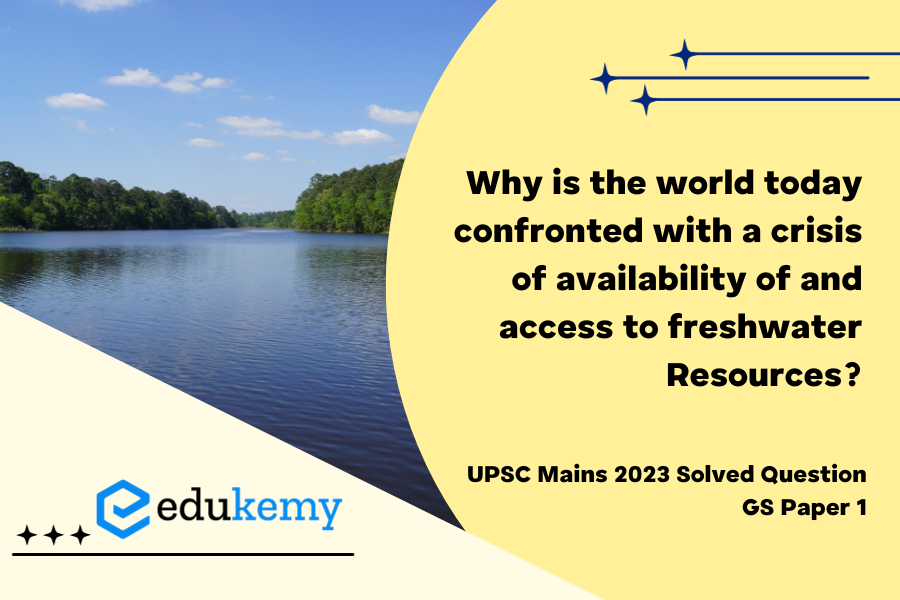UPSC Mains General Studies Paper – 1 Mains 2023
UPSC Mains Civil Services IAS Exam Question Paper – 2023
Contents
Introduction
According to UNESCO report 2 billion people i.e. 26% of population do not have safe drinking water and 3.6 billion lack access to Safely Managed Sanitation. With 98% Saline Water only 2% is left as Freshwater to erase the thirst of 8 Billion people , whose need for water can’t be summarized as its a basic necessity for Everyday Life as well as for Every Life .

Body
Reasons for crisis of availability of freshwater:
- Limited Freshwater Resources with 2% frozen glaciation remaining 1% getting distributed between groundwater, lakes ,rivers, etc. .
- Unequal distribution –Monsoons concentrate 85% of India’s precipitation in three month period only .Major crops grown in Agriculture based India such as Rice, Maize ,Ragi ,Groundnut etc. are majorly dependent on Monsoons thus any fluctuation or late arrival results in Food Security Issues.
- Population pressure in tropical countries results from low per capita resource availability. Water scarcity in Africa is expected to reach critical levels by 2025, affecting two-thirds of the global population. World Water Development Report 2023, around 80% of people living under water stress lived in Asia.
- Climate change causing prolonged droughts , Intense floods and destroying Natural Ecosystems. UN Climate change study shows that Wetlands are disappearing THREE times faster than Forests and in just 50 Years, since 1970-almost 35% of World’s Wetlands have been lost. Climate change is exacerbating both water related scarcity and water related hazards.
- Groundwater Exploitation and Overuse .
- Water Pollution due to increasing urbanization and industrialization. Contamination of water through Industrial discharges, Untreated sewage and with chemicals like Arsenic , Cadmium etc. making it unusable. Deforestation leading to disruptions of Hydrological Cycles .


REASONS FOR CRISIS IN ACCESS TO FRESHWATER-
- Geographical Disparities and Unequal Distribution- The Middle East with its Arid climate has 1% of world’s freshwater shared among 5% of world’s population and most water stressed countries are Bahrain , Cyprus , Kuwait ,Lebanon , Oman , Qatar all consumers of the 1% Availability. The most water stressed regions are Middle East and North Africa, where 83% of the population is exposed to extremely high water stress and South Asia , where 74% is exposed .
- Economic Water Scarcity due to lack of water infrastructure or poor management of water resources. The FAO estimates more than 1.6 Billion people face Economic Water Shortage probably because of unregulated water usage for Agriculture or Industry at the expense of the general population .
- Inefficiency in the Agricultural Sector with Faulty Practices such as unregulated use of Fertilizers and Pesticides giving rise to the phenomenon of Eutrophication of lakes and Water bodies further destroying the chances we have for freshwater access.
- Diminishing Natural reservoirs , drying up of rivers – Freshwater systems that feed a growing population have become stressed. For instance, the Aral Sea in Central Asia , Lake Mar Chiquita in Argentina , and the Dead Sea in the Middle East have dried up due to unstable water consumption. Rivers, lakes and aquifers are drying up or becoming too polluted to use.
- War and Water Disputes – Disputes stemming from Euphrates and Tigris Rivers among Turkey , Syria and Iraq. Jordan River conflict among Israel , Lebanon , Jordan and Palestine.Africa’s Nile River Conflict among Egypt , Ethiopia and Sudan.
- Forced migration and Refugee Crisis creates huge population pressure over resources and with current imbalances between Russia-Ukraine, India-Myanmar, Syria civil war ,Afghanistan Issue creates Informal Settlements which are often a problem for countries to rehabilitate and give access to resources.
Water crisis in INDIA :- India housing 16% of World’s Population possess only 4% of world’s Freshwater Resources .The Central Water Commission reported three major basins Krishna , Godavari and Kaveri as severely stressed with River Ken almost drying .Out of extracted Groundwater 90% are consumed by farmers, Hence its depletion increased by 23% from 2000 to 2017 in India. Some of the most cultivated crops are Wheat and Rice which are thirsty crops. Punjab rice paddies consume over 3 times the amount of rainwater that Punjab receives yearly.
Way forward
- Sustainable Water Management Practices .
- Water Conservation Efforts .
- Use of Technology such as Smart Irrigation System , Water Efficient Appliances, Wastewater Treatment Plants, Desalination Plants.
- Community Awareness and Engagements like Sacred Grooves.
- Greywater Management.
- Restoring Freshwater systems such as Wetlands – Everglades National Park of Florida one of the largest endangered wetlands is being restored with combined efforts of UNESCO and IUCN.
Conclusion
Hence, Indian Government Initiatives of Jal Jeevan Mission , AMRUT 2.0, Command Area Development and Water Management Programme are steps in the right direction for establishing proper distribution of Freshwater supply throughout. SDGs-6 for ensuring access to water and sanitation is itself one cornerstone to be covered by all . A Multifaceted Approach covering all aspects of Water Conservation is the need of the 21st century and its audience worldwide .
In case you still have your doubts, contact us on 8792740517.
For UPSC Prelims Resources, Click here
For Daily Updates and Study Material:
Join our Telegram Channel – Edukemy for IAS
- 1. Learn through Videos – here
- 2. Be Exam Ready by Practicing Daily MCQs – here
- 3. Daily Newsletter – Get all your Current Affairs Covered – here
- 4. Mains Answer Writing Practice – here
Visit our YouTube Channel – here


